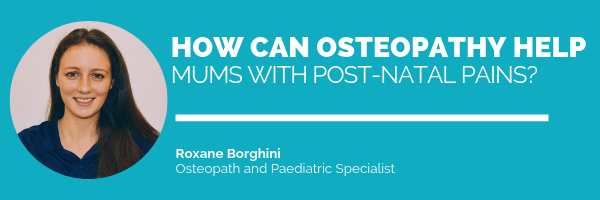
Once babies have arrived, mothers tend to forget about themselves and concentrate on their new-borns’ wellbeing. However it is important that mothers are in good health and happy in order to cope with the challenge of life with a new baby.
In Textbook of Pediatric Osteopathy, Moeckel & Mitha explain that “The mother’s state of mind is essential for successful bonding between mother and child. If she is exhausted, the mother will be irritable, soon feel overwhelmed by life, and be less able to respond to her child‘s need. This condition is often not only the result of a lack of sleep but also due to changing biomechanical factors that are initiated by giving birth” (Moeckel & Mitha, 2008; pp. 23). Brown and Lumley (1998) underline the prevalence of maternal physical and emotional health problems after delivery; Wu et al. (2004) confirm that around 25% of all postpartum women suffer from low back pain or pelvic girdle pain (cited in Schwerla et al., 2015).
New Mums will have faced postural changes during pregnancy and after delivery (e.g. with the increase of breasts in size and weight); mechanical strains from the labour (e.g. the pelvis and pelvic floor may have suffered from major stretching and unfavourable position); anatomical changes (e.g with vaginal delivery, bony structural changes combined with ligamentous laxity due to the pregnancy hormone relaxin, that relaxes the soft tissues of the pelvis to allow delivery); Biomechanical changes (eg. the use of Epidural anaesthesia may have reduced the muscles tone of the pelvic floor, thus not enabling baby’s head to rotate out of the birth canal easily and instead add extra stress on the pelvis); Episiotomy, the use of ventouse or forceps or a Caesarean section may have caused tissue trauma; …. many factors that can lead to discomfort or induce side effects such as headaches and backaches.
As an adjunct to standard care, Osteopathy has shown to be efficacious for pain management after both caesarean and vaginal delivery. Our osteopaths can address LBP and PGP, relax contracted muscle tissues, relieve joint pain and alleviate ligamentous stress and strain, as well as reduce scar tension around the pelvic area and abdomen – that is, help the body to regain strength and flexibility. Our practitioners will also provide postural advice best adapted to mothers caring for their new-born.
References
Hastings, V., McCallister, A.M., Curtis, S.A., Valant, R.J. and Yao, S. (2016). Efficacy of Osteopathic Manipulative Treatment for Management of Postpartum Pain. JAOA. (116)8. pp. 502-509
Moeckel, E. and Mitha, N. (2008). Textbook of Pediatric Osteopathy. Elsevier Ltd
Schwerla, F., Rother, K., Rother, D., Ruetz, and M., Resch, K.L., (2015). Osteopathic Manipulative Therapy in Women With Postpartum Low Back Pain and Disability: A Pragmatic Randomized Controlled Trial. JAOA. (115) 7. pp.416-425



